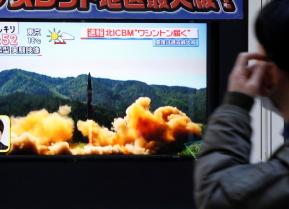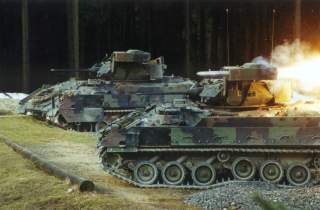How the Army Plans to Save the Bradley Fighting Vehicle: Iron Fist Anti-Missile ‘Shields’
Or, is this old weapon of war just obsolete?
In December 2018, the U.S. Army announced its intent to urgently outfit an armored brigade of 138 Bradley Infantry Fighting Vehicles with the Israeli-built Iron Fist Active Protection System.
What’s Iron Fist? No, not the Marvel superhero—though like Danny Rand, the system in question has extraordinary reflexes—able to detect and swat down an incoming anti-tank missile within one-third of a second.
The Army’s decision is far from surprising, as it has been testing Iron Fist on the Bradley for the last couple of years. The Army will eventually spend $200 million through 2020 to upgrade an entire brigade, though only $80 million of the necessary funding is currently available. Eventually, the Army intends to outfit all of its vehicles with APSs due to the demonstrated lethality of modern anti-tank missiles in Middle Eastern wars. Army leaders made clear they see the system as an “urgent requirement”—likely due to the threat posed by Russian anti-tank missiles like the AT-14 Kornet.
Earlier in 2017, the Army announced it would equip a brigade of M1 tanks with the older Trophy Active Protection System, built by the Israeli Rafael firm. At least three more brigades are set to receive it. Trophy uses two radars to direct a shotgun-like system to blast incoming missiles (you can read more about it here.) Trophy-protected Israeli Merkava IVM tanks shot down numerous anti-tank projectiles without suffering a single loss during a 2014 war with Hamas. This was eight years after twenty-seven Israeli Merkavas without APSs were damaged or destroyed fighting Hezbollah forces in Lebanon.
However, Trophy is heavy and has significant power consumption demands. Furthermore, there have long been concerns that hard-kill projectiles could harm nearby friendly troops.
After losing a competition versus Trophy in 2006, competing Israeli firm IMI developed the purportedly safer Iron Fist system, which adds in a “soft kill” measure. IMI partnered with General Dynamics to market the system to the U.S. Army for its M2 Bradley Infantry Fighting Vehicle—a heavily-armed troop carrier. One of the most heavily armored vehicles in its class, the thirty-ton Bradley’s power-train is already overtaxed and its turret already crammed full of sensors and weapons, so it was decided the smaller, 450-pound Iron Fist Light model should be tested on it. Even then, components from a still-under-development M2A4-model Bradley had to be retrofitted to generate adequate power, delaying the testing process.
Trophy and Iron Fist are primarily designed to defeat two types of man-portable weapons. The smaller rocket-propelled grenade (RPG) is cheap, widely available and highly portable. RPGs are manually aimed and have a range of a maximum effective range of few hundred meters. They have proven particularly effective for ambushes in dense urban terrain, having destroyed over one hundred Russian armored vehicles in the Battle of Grozny, shot down U.S. helicopters in Mogadishu, and posed a threat to American armor from the Vietnam War to the invasion of Iraq.
Anti-tank Guided Missiles (ATGMs) are larger, far more sophisticated systems with ranges typically measured in multiple kilometers, and some form of guidance, whether it be via a connecting wire, a laser designator, or infrared sensor. ATGMs teams concealed like super-heavy snipers miles away have destroyed hundreds of tanks in the Syrian Civil War, including older T-55, T-62, and Turkish M60 Patton tanks, as well as comparatively modern M1 Abrams, Leopard 2 and T-90A main battle tanks.
Neither type of projectile usually depends on kinetic energy to penetrate armor—instead, upon impact, most detonate a shaped-charge (or HEAT) warhead which blasts a cone of molten metal into the target.
A third threat the Iron Fist reportedly may work against is that posed by kamikaze drones, which have featured prominently in recent Middle Eastern conflicts.
The Iron Fist employs both an infrared sensor and two active-electronically scanned array radars with 200-degrees of horizontal and 70 degrees vertical coverage. These can detect incoming projectiles, and can also be used for more routine scanning purposes. Besides improving sensor returns, the infrared sensor serves as a passive backup in case the vehicle crew wants to turn off the active radars for stealth purposes. The Iron Fist’s open architecture also allows for integration with additional external sensors, such as Laser Warning Receivers and battle management software, to create an even better sensor picture.
An Iron Fist protected vehicle mounts two small turrets, each carrying two mortar-like launch tubes which automatically swivel to face a detected threat. These can react quickly enough to reliably counter RPGs and missiles launched as close 50 to 150 meters away (depending on projectile speed.) The turrets launch a non-fragmenting charge specifically designed to minimize the risk of collateral damage to nearby friendly troops or civilians, whom are especially likely to be present near an infantry carrier.
Rather than impacting the incoming missile, the charge detonates a short distance away, creating a shockwave that either disintegrates the projectile or knocks it off course—in theory, without detonating their warhead. The APS’s computer calculates which part of the project to impel to minimize the probability of damage to friendlies.
You can see an Iron Fist swatting an RPG-7 in this video.
One threat the Iron Fist Light is not designed to stop is higher-velocity kinetic anti-tank shells, like those typically used by main battle tanks. The heavier basic Iron Fist model designed for tanks supposedly is capable of tilting the shells off target to suboptimal angles for penetration—by one calculation, jarring a shell by just 10 degrees could reduce penetration by 50 percent. The same analysis speculates, however, that Iron Fist’s countermeasure may be too slow to counter very high-velocity kinetic penetrators.
In any case, degrading kinetic shell penetration will only likely benefit more heavily armored vehicles, as tank shells over-penetrate most non-tank armored vehicles to a considerable degree. The heavy Iron Fist model also adds on an electro-optical jammer to try throwing the guidance sensors of certain types of missiles astray, similar in principle to the eye-like jammers on the T-90 tank.
However, an advantage of the Iron Fist Light model is that it could (in theory) be bolted on the roof of all kinds of vehicles. In August 2018 the Army terminated testing of the U.S.-designed Iron Curtain APS system for the Stryker, claiming the system was immature, though reportedly the Army is considering Trophy Light or the German ADS system instead.
The Army is separately planning on a Modular Active Protection System that could be fitted on any combination of vehicles and sensors.
Unless major flaws emerge during operational testing, there’s every indication that Active Protection Systems like Iron Fist and Trophy will eventually become a standard feature on U.S. armored vehicles and possibly even unarmored ones in high-risk combat zones. This is promising, as available evidence from testing and the battlefield suggest that APSs dramatically improve the survivability of vehicle-mounted soldiers against very common and deadly battlefield threats.
Sébastien Roblin holds a master’s degree in conflict resolution from Georgetown University and served as a university instructor for the Peace Corps in China. He has also worked in education, editing, and refugee resettlement in France and the United States. He currently writes on security and military history for War Is Boring.
Image: Wikimedia Commons.


